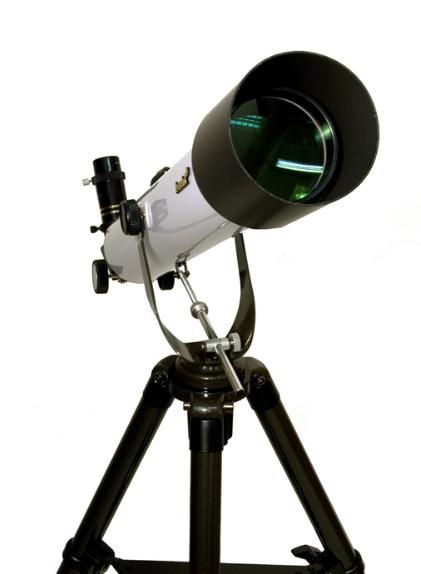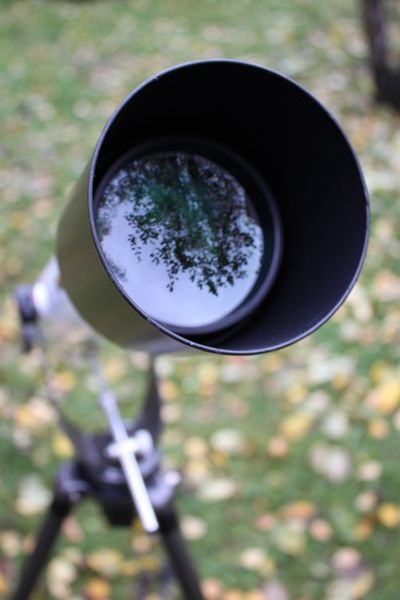Telescope Under a Microscope: How Does It Work?
Imagine a human eye five centimeters in diameter. Now, imagine that there is also half a meter from its pupil to the retina. This is basically what a telescope is - a giant eyeball. Our eye acts as a lens: it doesn't see the objects themselves, it sees the light reflected from their surface (that's also why we don't see anything in the dark). Light passes through the crystalline lens to the retina, which sends impulses to our brain, which, in turn, forms a picture. The only difference between a human eye and a telescope is that the telescope lens is much bigger and, therefore, gathers light even from distant objects that our eye simply cannot see.
Even though the principle is the same, telescopes vary in design. First, let's talk about refracting telescopes, or refractors. A refractor is basically a tube with a double-convex lens - like this: ( ) - on each end. They gather light from celestial objects, refract it, and focus it, so we can see an image in the eyepiece.
Levenhuk Strike 80 NG Telescope
Now, let's move on to reflecting telescopes, or reflectors. Instead of refracting light rays, they reflect them. A basic reflector is a tube with two mirrors inside. There is an objective lens at the front, a bigger mirror in the back, and a smaller mirror in the middle of the telescope tube. Light that passes through the objective lens is reflected from the larger mirror to the smaller one-mounted at a specific angle - which then reflects the rays to the eyepiece, where we see the resulting image of an object.
You can easily tell a reflector from a refractor: reflectors have their eyepieces mounted on the side of the tube, while refractors have them on the end of the telescope tube.
As with Nikon vs. Canon, reflectors vs. refractors has been a subject of many heated discussions among stargazers the world over. Let's take a closer look at both optical designs. Refractors are easier to use and maintain; you can easily transport them without worrying about breaking mirrors, and store them without dreading a speck of dust getting inside the telescope tube. Terrestrial observations aren't a problem either because the produced image is not inverted. Reflectors are far more fragile but allow you to study deep-sky objects and try your hand at astrophotography. In general, refractors are better suited for beginners, while reflectors are perfect for experienced stargazers.
Well, since refractors are simpler, we'll be using them as an example, to better understand the way telescopes work, and we'll be using Strike NG telescopes from Levenhuk for that purpose because they are perfect for beginners.
This is a lens that gathers light. As lenses are made of glass, this optical design has its limitations - you can't make them too big because a large size will also make them very heavy. Yerkes Observatory in the USA has the largest operating refractor with a 102 cm (40'') objective lens.
You can see through the lens that the telescope tube is black inside, so as to reduce glare from bright objects.
This is a dew cap that - as the name suggests - protects the objective lens from dewfall. It also safeguards the lens from scratches and slight impacts. It even reduces glare from nearby streetlamps and such.
An eyepiece. We observe the skies through this little thing.
The diagonal mirror - together with an eyepiece and a Barlow lens - is needed to see an upright image. With it, we can use our telescope for terrestrial observations, one of which we see in this picture.
This picture was taken with an SLR-camera mounted on the telescope, in place of an eyepiece. You do need an adapter for this.
Not all refractors accept a camera. For instance, the basic model of Strike NG series does not, but it still costs about a 100 dollars, so... quid pro quo.
And finally for the breathtaking part... Photographs that can be made with a telescope.
This was made in autumn with a Levenhuk Strike 80 NG refractor. As you can see, the image is very sharp; however, the quality is greatly reduced when galaxies or other planets are photographed with a refractor. This is, after all, an entry model, your first stepping stone into the world of astronomy. And you can easily carry it around on your trips and use it to observe and photograph terrestrial objects.
Any reproduction of the material for public publication in any information medium and in any format is prohibited. You can refer to this article with active link to eu.levenhuk.com.
The manufacturer reserves the right to make changes to the pricing, product range and specifications or discontinue products without prior notice.














